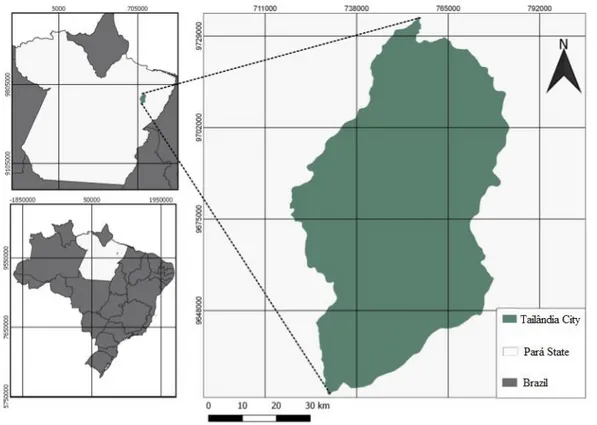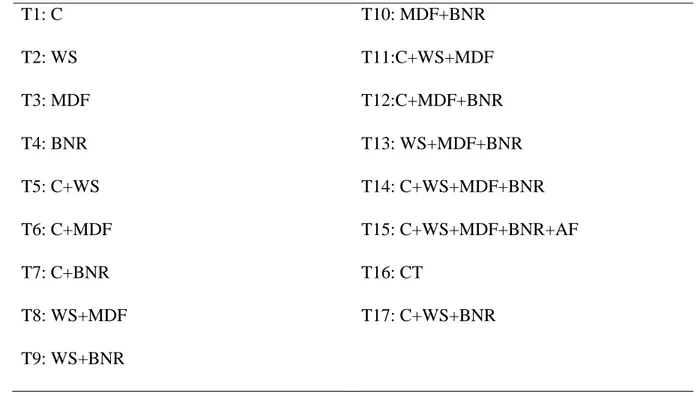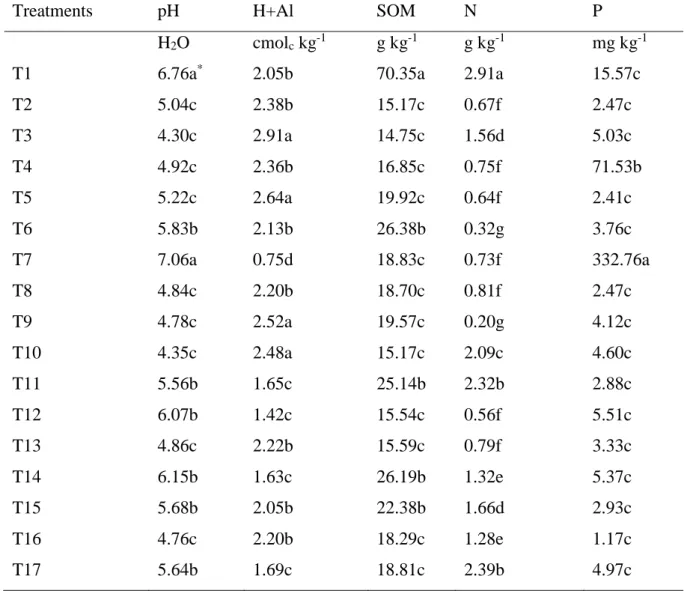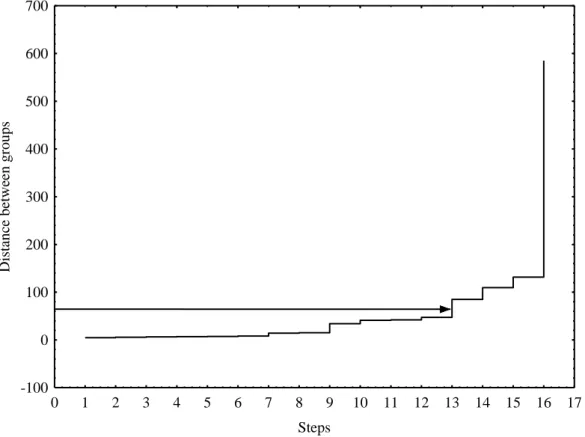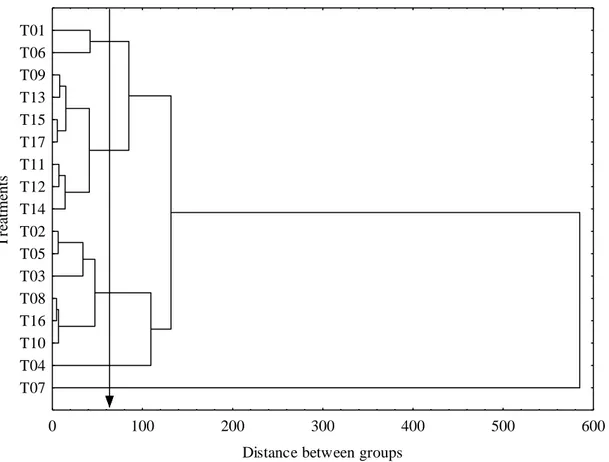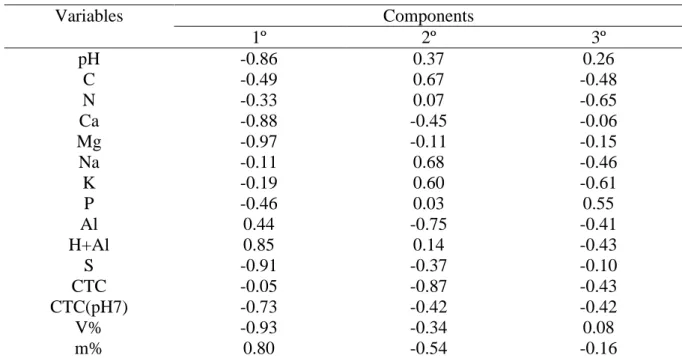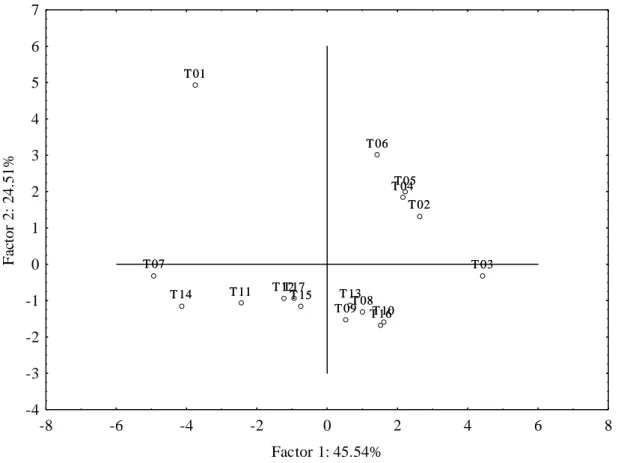Determination of soil chemical attributes with terra preta nova experiment
Determinação dos atributos químicos do solo com experimento terra preta nova
DOI:10.34117/bjdv6n5-227
Recebimento dos originais: 13/04/2020 Aceitação para publicação: 13/05/2020
Cândido Milton Pinto Gama
Mestre em Agronomia pela Universidade Federal Rural da Amazônia Instituição: Universidade Federal Rural da Amazônia
Endereço: Av. Presidente Tancredo Neves, 2501, Bairro Terra Firme, Belém – PA, Brasil E-mail: candidomilton_16@hotmail.com
Maria de Lourdes Pinheiro Ruivo
Doutora em Agronomia pela Universidade Federal de Viçosa Instituição: Museu Paraense Emílio Goeldi
Endereço: Av. Perimetral, 1901, Bairro Terra Firme, Belém – PA, Brasil E-mail: ruivo@museu-goeldi.br
Dirse Clara Kern
Doutora em Geologia e Geoquímica pela Universidade Federal do Pará Instituição: Museu Paraense Emílio Goeldi
Endereço: Av. Perimetral, 1901, Bairro Terra Firme, Belém – PA, Brasil E-mail: kern@museu-goeldi.br
Ricardo Shigueru Okumura
Doutor em Agronomia pela Universidade Estadual de Maringá Instituição: Universidade Federal Rural da Amazônia
Endereço: Rodovia PA 275, km 13, Zona Rural, Parauapebas – PA, Brasil E-mail: ricardo.okumura@ufra.edu.br
Milena Carvalho de Moraes
Doutora em Química pela Universidade Federal do Pará Instituição: Museu Paraense Emílio Goeldi
Endereço: Av. Perimetral, 1901, Bairro Terra Firme, Belém – PA, Brasil E-mail: milenamoraes@museu-goeldi.br
Daiane de Cinque Mariano
Doutora em Agronomia pela Universidade Estadual de Maringá Instituição: Universidade Federal Rural da Amazônia
Endereço: Rodovia PA 275, km 13, Zona Rural, Parauapebas – PA, Brasil E-mail: daiane.cinque@ufra.edu.br
Cândido Ferreira de Oliveira Neto
Doutor em Ciências Agrárias pela Universidade Federal Rural da Amazônia Instituição: Universidade Federal Rural da Amazônia
Endereço: Av. Presidente Tancredo Neves, 2501, Bairro Terra Firme, Belém – PA, Brasil E-mail: candido.neto@ufra.edu.br
Ismael de Jesus Matos Viégas
Doutor em Agronomia pela Escola Superior de Agricultura Luís de Queiroz Instituição: Universidade Federal Rural da Amazônia
Endereço: Av. Barão de Capanema, s/nº, Bairro Caixa D’Água, Capanema – PA, Brasil E-mail: ismael.viegas@ufra.edu.br
ABSTRACT
Research conducted with Terra Preta Nova (TPN) experiment has been directed in the attempt to replicate soils known as Archeological Black Earth (ABE), characterized by being highly fertile and stable soils, associated with deposit of vegetal and animal residues origin by prehistoric man. The aims of this study were to evaluate the influence of soil chemical attributes on incorporation of wood residues and animal wastes in Terra Preta Nova experiment. The experimental design was randomized blocks, with 17 treatments consisting of incorporation of substrates in soil, individual or combined, of charcoal (C); wood sawdust (WS); MDF residues (MDF); bone meal residues (BNR); animal fat (AF); and control treatment (CT), without incorporation of substrate in soil, with four replicates. The incorporation and combinations of substrates promoted increase in soil organic matter, verifying that individual treatment based on charcoal resulted in a value of 70.35 g kg-1 of SOM, for P nutrient verified value of 332.76 mg kg-1 (C+BNR). For N and exchangeable bases contents (K, Na, Ca, and Mg), verified low values, without modifications with incorporation of different substrates in soil. The areas conducted with Terra Preta Nova experiment showed values of low soil chemical attributes compared to Archeological Black Earth, suggesting that time in which residues were incorporated was not sufficient for formation of soil fertility, characteristic of Archeological Black Earth.
Key words: Archeological Black Earth, organic residue, soil fertility.
RESUMO
Pesquisas conduzidas com experimento Terra Preta Nova (TPN) tem sido direcionada na tentativa de replicar os solos conhecidos como Terra Preta Arqueológica (TPA), caracterizados por serem solos altamente férteis e estáveis, associada ao depósito de material de origem vegetal e animal pelo homem pré-histórico. O objetivo do estudo foi avaliar a influência nos atributos químicos do solo da incorporação de resíduos madeireiros e restos de animais no experimento Terra Preta Nova. O delineamento experimental foi blocos ao acaso, com 17 tratamentos constituídos pela incorporação de substratos no solo, na forma individual ou combinada, de carvão (C), resíduos de pó de serra (RPS), resíduos de lâmina triturada (RLT), resíduos de ossos (RA), sangue + gordura (S) e o controle (sem incorporação de substrato no solo), com quatro repetições. A incorporação e combinações dos substratos promoveram incremento no teor de MO do solo, verificando que o tratamento individual a base de carvão resultou em valor de 70,35 g kg-1 de MO, para o nutriente P verificou valor de 332,76 mg kg-1 para a combinação sem incorporação de substrato no solo carvão e resíduos de ossos. Com relação aos teores de N e as bases trocáveis (K, Na, Ca e Mg) verificou valores baixos, sem modificações com a incorporação de substratos no solo. As áreas conduzidas no experimento Terra Preta Nova apresentaram valores dos atributos químicos baixos comparativamente aos de Terra Preta Arqueológica, sugerindo que o tempo que os resíduos foram incorporados não foi suficiente para a formação da fertilidade do solo característicos de Terra Preta Arqueológica.
1 INTRODUCTION
Archeological Black Earth (ABE) occur frequently in the Amazon region, formed from the prehistoric human occupation, usuallly called as "Terra Preta de Índio", shows anthropogenic A horizon (Au) or archaeo-anthropedogenic (KÄMPF and KERN, 2005).
Archeological Black Earth are highly fertile and stable, without the need for chemical fertilization for 15 years (COSTA et al., 2015), justified by greater population and diversity of microorganisms, in which promote exudation of organic substances (AMARANTE et al., 2010). ABE soils show stability of organic matter, around six times greater (MOREIRA et al., 2009), high of phosphorus, calcium and magnesium contents (BARROS et al., 2012), higher CTC, higher pH, and low aluminum contents compared to agricultural soils (MADARI et al., 2009).
ABE soils due their attributes favorable to agricultural use, are, in many cases, used by local communities in family agriculture, but agricultural use of ABE soils is not desirable, since it is Brazil's historical heritage. The knowledge of ABE soils for agriculture, their limitations of use and process of soil formation, promoted the development of Terra Preta Nova experiment, in which aimed to replicate ABE soils using organic residues from sawmills, slaughterhouses, and charcoal (MONTEIRO et al., 2006), promoting greater soil biological activity (LEONCIO et al., 2011), contributing in improvement of soil quality resulting from increased humification of fresh organic matter, increasing the macro and micronutrients contents in soil and availability to plants (VALARINI et al., 2002).
The organic residues enable production of substrates to be incorporated in soil, with the objective of improving the physical, chemical, and biological attributes of soil, besides promoting a socio-environmental destiny for residues (NEVES et al., 2012), previously stored in inadequate forms. Terra Preta Nova experiment considers the effects of prolonged administration on soil, being supported in three fundamental bases: conservation of urban and rural ecosystems; development of a sustainable system of resources of ground; and diffusion of sustainable ecological, social, and economic management (KERN et al., 2009). In other countries, such as Germany, research has been carried out to produce or replicate ABE soils, called "biochar", characterized by carbonization of organic matter and applied to the soil deliberately (MEYER et al., 2011).
Important information can be obtained about the operation of Terra Preta Nova soils in an attempt to replicate, in period of decades and not centuries, to be used in development of sustainable agricultural systems, mainly for benefit of small farmers and local communities.
By monitoring the soil characteristics incorporated organic residues, and comparison between the soils submitted to Terra Preta Nova experiment, Archeological Black Earth, and agricultural, will allow the formation of a database that promotes the diffusion of technology for
sustainability of agriculture in tropical ecosystems. Thus, the aims of this study were to evaluate the influence of soil chemical attributes on incorporation of wood residues and animal wastes in Terra Preta Nova experiment.
2 MATERIAL AND METHODS
The Terra Preta Nova experiment was conducted in an area of 4 ha in experimental area of Tailâminas Plac Company (02 57’ 021’’S, and 048 57’ 21’’W), Tailândia city, Brazil (Figure 1). The choice of experimental area occurred due to presence of slaughterhouses and because it is one of largest wood production zones in Brazil, in which about 50% of wood cut is not used by companies and remains of carcass from slaughterhouses and butchers are incinerated or accumulated in inappropriate places.
Figure 1 - Location of Tailândia city, Pará state, Brazil.
The Terra Preta Nova experiment started in March 2004, with incorporation of residues in experimental area, installed away from interference, such as buildings and trees plantations. The experimental design was randomized blocks, consisting of 17 treatments (Table 1), with four replications, each plot with dimensions of 3m x 3m, totaling 68 plots.
Table 1 - Terra Preta Nova experiment consisting of treatments based on charcoal (C); wood sawdust (WS); MDF residues (MDF); bone meal residues (BNR); animal fat (AF); and control treatment (CT), incorporated in soil of Tailândia city, Brazil.
T1: C T10: MDF+BNR T2: WS T11:C+WS+MDF T3: MDF T12:C+MDF+BNR T4: BNR T13: WS+MDF+BNR T5: C+WS T14: C+WS+MDF+BNR T6: C+MDF T15: C+WS+MDF+BNR+AF T7: C+BNR T16: CT T8: WS+MDF T17: C+WS+BNR T9: WS+BNR
After 6 years of incorporation in soil of substrates, in period of March 2010, soil samples were taken from the surfasse layer (0-20 cm) of arable fields, identified and individually packed. Then, were sent to the Museu Emilio Goeldi to carry out the soil chemical analyzes.
The chemical analysis procedures were performed according to methodology described by Donagema et al. (2011), evaluating the pH in water and KCl 1N, by potentiometric method (1:2.5 soil:solution ratio). The exchangeable cations (Ca2+, and Mg2+) were extracted by 1N potassium chloride (KCl) solution at pH 7.0 and determined by atomic absorption. Na+ was extracted with 0.05N HCl + 0.025N H2SO4 and determined by flame photometry. The potential acidity (H + Al3+)
was extracted with 0.05N calcium acetate at pH 7.0 and quantified by titration with NaOH. From the exchangeable cations contents were calculated: sum of bases (𝑆𝐵 = 𝐶𝑎2++ 𝑀𝑔2++ 𝐾+ + 𝑁𝑎+); cation exchange capacity [𝐶𝐸𝐶 = 𝑆𝐵 + (𝐻 + 𝐴𝐿3+)]; base saturation (𝑉% = 𝑆𝐵
𝐶𝑇𝐶∗ 100).
The P was extracted by Mehlich-1 (0.05N HCl and 0.025N H2SO4) solution and determined by
colorimetric method. The organic carbon was determined by oxidizing action of 1N potassium dichromate (K2Cr2O7) in acid medium and quantified by titration with 1N ammoniacal ferrous
sulfate solution, with result the organic matter (OM) was calculated using the equation (𝑂𝑀 = 𝑜𝑟𝑔𝑎𝑛𝑖𝑐 𝑐𝑎𝑟𝑏𝑜𝑛 ∗ 1.72). Nitrogen was determined by the diffusion chamber method.
Initially, the experimental data submitted to test the normality and homogeneity of variance (p>0.01). The treatment means were compared by Scott-Knott test, at 5% probability, by using the statistical software Sisvar (FERREIRA, 2019).
3 RESULTS AND DISCUSSIONS
The incorporation of organic residues influenced the increase in soil pH, showing a higher value than control treatment (T16), in which the treatments charcoal + bone meal residues (T7), and charcoal (T1) obtained the highest pH values of 7.06, and 6.76, respectively, while the control treatment was 4.76 (Table 2). The incorporation of organic residues promoted the correction of soil pH, corroborating with results obtained by Monteiro et al. (2010), verified in Tailândia city the increase of soil pH, with values of 5.6 for soil incorporated organic residues and 5.2 for agricultural soils.
Table 2 - Soil chemical attributes (pH, H+Al, SOM, N, and P) as a function of treatments in Terra Preta Nova experiment.
Treatments pH H+Al SOM N P
H2O cmolc kg-1 g kg-1 g kg-1 mg kg-1
T1 6.76a* 2.05b 70.35a 2.91a 15.57c
T2 5.04c 2.38b 15.17c 0.67f 2.47c T3 4.30c 2.91a 14.75c 1.56d 5.03c T4 4.92c 2.36b 16.85c 0.75f 71.53b T5 5.22c 2.64a 19.92c 0.64f 2.41c T6 5.83b 2.13b 26.38b 0.32g 3.76c T7 7.06a 0.75d 18.83c 0.73f 332.76a T8 4.84c 2.20b 18.70c 0.81f 2.47c T9 4.78c 2.52a 19.57c 0.20g 4.12c T10 4.35c 2.48a 15.17c 2.09c 4.60c T11 5.56b 1.65c 25.14b 2.32b 2.88c T12 6.07b 1.42c 15.54c 0.56f 5.51c T13 4.86c 2.22b 15.59c 0.79f 3.33c T14 6.15b 1.63c 26.19b 1.32e 5.37c T15 5.68b 2.05b 22.38b 1.66d 2.93c T16 4.76c 2.20b 18.29c 1.28e 1.17c T17 5.64b 1.69c 18.81c 2.39b 4.97c
*means followed by the same letters within columns are not significantly different by Scott-Knott test at the 0.05 probability level.
Potential acidity (H + Al) contents were statistically different (Table 2), however, it was not a result of organic residues incorporated in soil, since treatments with the presence showed lower values (T11, T12, T14, and T17), and higher values (T3, T5, T9, and T10) compared to control treatment (T16).
Treatments constituted by MDF residues (T3), and charcoal + wood sawdust (T5) obtained potential acidity contents of 2.91, and 2.64 cmolc kg-1, respectively, due to dissociation of H+ ions from functional groups present in SOM (MEURER, 2012). Despite the high values, did not promote alteration in soil pH (T3: 4.30; T5: 5.22), due to buffering capacity of SOM (MEURER, 2012).
From the information in Table 2, soil organic matter (SOM) content was higher in treatments containing charcoal in its composition, T1 (charcoal) obtained the highest value (70.35 g kg-1), due charcoal is a source of carbon and stable organic matter (MADARI et al., 2011). The charcoal in form of small fragments shows absorption activity of soluble organic compounds, water retention, and local to soil microorganisms (BENITES et al., 2005). However, in charcoal-associated treatments (T5: 19.92 g kg-1; T7: 18.83 g kg-1; T12: 15.54 g kg-1; T17: 18.81 g kg-1) showed no significant difference compared to control treatment (T16: 18.29 g kg-1).
For soil organic matter, charcoal treatment (T1: 70.35 g kg-1) showed satisfactory and interesting results, demonstrating the possibility of elevation in soil contents in poor soils, as well as attempt of replication Archeological Black Earth soil. According to Madari et al. (2011) the organic matter in Archeological Black Earth soil shows greater stability and low availability, due to high chemical reactivity (CUNHA et al., 2007), promoting greater accumulation compared to agricultural soils.
N showed variation in contents (0.32 to 2.91 g kg-1) (Table 2), due to mineralization of OM
and consequent increase in availability of N (SCHULZ and GLASER, 2012). Neves et al. (2011) verified in same region of Terra Preta Nova experiment, with the same treatments adopted in present study, that N contents are susceptible to seasonal influences, with higher levels of N in dry period of year, justifying the low levels obtained collected during the rainy season. In addition, with information showed in Table 2, it was verified that control treatment (T16) obtained a low N content (1.28 g kg-1), suggesting N deficiency in Terra Preta Nova experiment.
The high P content obtained in treatment T7 (C+BNR) occurred due to changes in soil P dynamics promoted by organic fertilization (HORST et al., 2001), since bone residues are highly concentrated in P, almost 80% of P in animal organism is in bone tissue, associated with Ca, in
form of tricalcium and trimagnesian phosphate (ANDRIGUETO et al., 2002). Associated with slow and gradual mineralization of soil organic matter, providing greater release and better redistribution of organic forms of P, more mobile in soil and less adsorption reactions (NOVAIS et al., 2007). According to Xavier et al. (2009) the behavior of P redistribution in agroecosystems is dependent on specific characteristics, and availability is related to the cycling of its organic compartment.
The treatment T4 (BNR) with a content of 71.53 mg kg-1 (Table 2), lower value only to T7
(C+BNR), showing the use of bone residues as a P alternative in soil. In Terra Preta Nova experiment only treatments based on charcoal (T1), bone meal residues (T4), and charcoal + bone meal residues (T7) showed increase in soil contents.
From the information in Table 3, potassium (variation of 0.006 to 0.032 cmolc kg-1) and
sodium (variation of 0.04 to 0.29 cmolc kg-1), showed low contents in Terra Preta Nova experiment,
contributing with less than 2% of CEC. The charcoal treatment (T1) promoted a higher soil increase of 0.032 cmolc kg-1 for potassium and 0.29 cmolc kg-1 for sodium (Table 3).
Table 3 - Soil chemical attributes (K, Na, Ca, Mg, SB, CEC, and V%) as a function of treatments in Terra Preta Nova experiment.
Treatments K Na Ca Mg SB CEC V
--- cmolc kg-1 ---
%
T1 0.032a* 0.29a 1.99d 0.58a 2.90c 4.95b 58.78c
T2 0.015c 0.18b 0.69e 0.23d 1.11e 3.50d 31.94e
T3 0.013c 0.14b 0.44e 0.13e 0.72e 3.63d 19.73f
T4 0.012c 0.15b 0.83e 0.21d 1.20e 3.56d 33.64e
T5 0.018b 0.16b 0.85e 0.22d 1.26e 3.89d 32.24e
T6 0.019b 0.04d 0.82e 0.18d 1.06e 3.18d 34.26e
T7 0.012c 0.09c 3.37b 0.59a 4.06b 4.81b 84.19a T8 0.016c 0.08c 1.82d 0.36c 2.27d 4.48c 51.70d T9 0.015c 0.09c 2.33c 0.36c 2.79c 5.31b 52.54d T10 0.020b 0.09c 1.76d 0.29c 2.16d 4.64c 46.49d T11 0.015c 0.07c 3.04b 0.55a 3.68b 5.33b 68.68b T12 0.006d 0.07c 2.45c 0.43b 2.96c 4.38c 67.89b T13 0.006d 0.04d 2.08d 0.32c 2.44c 4.67c 52.37d
T14 0.020b 0.14b 4.09a 0.59a 4.84ª 6.47a 74.56b
T15 0.009d 0.05d 2.47c 0.40b 2.93c 4.98b 59.01c
T16 0.012c 0.04d 1.74d 0.28c 2.07d 4.27c 48.41d
*means followed by the same letters within columns are not significantly different by Scott-Knott test at the 0.05 probability level.
The contribution of calcium, and magnesium nutrients were more significant for soil CEC, in which values ranged from 0.82 to 4.09 cmolc kg-1, and 0.13 to 0.59 cmolc kg-1, respectively
(Table 3). The low content of exchangeable bases observed in treatments occurred by soil characteristics, in which it was classified as Latosol (Oxisol) (EMBRAPA, 2013), associated to period of collection that was carried out during the rainy season.
The calcium and magnesium contents were lower in organic residues treatments, showing that in treatment with MDF residues (T3), values of 0.44 cmolc kg-1 (Ca) and 0.13 cmolc kg-1 (Mg)
compared to control treatment (T16), which presented values of 1.74 cmolc kg-1 (Ca) and 0.28 cmolc
kg-1 (Mg). The short time that incorporated organic residues were disposed in experimental area did not allow time for microorganisms to start the process of mineralization of organic matter (CAMPOS et al., 2011), and later release of nutrients in soil.
The low contents obtained for base sum varied from 0.72 to 4.84 cmolc kg-1 in treatments
consisting of MDF residues (T3) and charcoal + wood sawdust + MDF residues + bone meal residues (T14), respectively (Table 3) were probably provided by low exchangeable base contents obtained in experiment, in which are susceptible to variation in edaphoclimatic conditions, subject to loss of exchangeable bases by leaching (CAMPOS et al., 2012).
Although showed low CEC and SB contents, the Terra Preta Nova experiment resulted in an increase in soil chemical attributes, showing that values of CEC were influenced by sum of bases, with a minimum of 3.50 cmolc kg-1 in with wood sawdust (T2), and maximum of 6.47 cmolc kg-1 in
with charcoal + wood sawdust + MDF residues + bone meal residues (T14) treatment (Table 3). According to Glaser and Birk (2012) CEC and sum of bases tend to increase with incorporation of organic residues, being reported by Liu et al. (2012) founded that CEC varied from 10 cmolc kg-1 in
control treatment (without incorporation of organic residues) to 13 cmolc kg-1 with biochar
treatment (sand, charcoal, and wood sawdust).
The base saturation showed different mean values between treatments with amplitude of values, observing the lower value of 19.73% obtained by MDF residues treatment (T3) and highest value of 84.19% in charcoal + bone meal residues treatment (T7) (Table 3). Most of treatments promoted base saturation content above 50%, thus classifying the soils as eutrophic, except for treatments with use of wood sawdust (T2, T3, T4, T5, T6, and T10) and control treatment (T16), in which showed values lower than 50% (dystrophic).
The Terra Preta Nova experiment promoted improvements in soil chemical attributes with incorporation of organic residues, mainly those derived from wood sawdust. Monteiro et al. (2010), studying the incorporation of wood sawdust to improve the soil chemical attributes, verified similar results to present study.
By clustering analysis, 5 groups were observed, in which each group consisted of treatments that showed similarity. The phenon line that identified the formation of 5 groups was inserted at the point with greatest dissimilarity between the groups (Figure 2).
0 1 2 3 4 5 6 7 8 9 10 11 12 13 14 15 16 17 Steps -100 0 100 200 300 400 500 600 700 D ist anc e bet w een gro ups
Figure 2 - Phenon line with Euclidean distances in which the groups were formed along the clustering steps.
According to dendogram showed in Figure 3, the wood sawdust + MDF residues (T8), and control treatment (T16) were the most similar among them, since presented the smallest Euclidean distance compared to other treatments. Evidence that T8 treatment (wood sawdust + shredded wood) was the least differentiated from T16 (control treatment).
0 100 200 300 400 500 600 Distance between groups
T07 T04 T10 T16 T08 T03 T05 T02 T14 T12 T11 T17 T15 T13 T09 T06 T01 T re at m ent s
Figure 3 - Dendogram of treatments constructed by soil chemical attributes and formed by grouping of means of groups of similar points.
Efficiently, cluster analysis formed 5 groups, T1 (C), and T6 (C + MDF) treatments formed group 1, both treatments have charcoal in composition. The T9 (WS + BNR), T11 (C + WS + MDF), T12 (C + MDF + BNR), T13 (WS + MDF + BNR), T14 (C + WS + MDF + BNR), T15 (C + WS + MDF + BNR + AF), and T17 (C + WS + BNR) treatments formed group 2, being mostly treatments formed by three or more substrates. The T2 (WS), T3 (MDF), T5 (C + WS), T8 (WS + MDF), T10 (MDF + BNR), and T16 (CT) treatments formed the group 3, being the majority constituted by two types of substrates, as well as treatments only of wood sawdust. T4 (BNR) treatment formed group 4, and T7 (C + BNR) treatment formed group 5. T4 and T7 treatments were distinguished from other treatments and among them, since formed two groups separately, as specificity the treatments showed bone meal residues in composition.
The principal component analysis (PCA) was performed in data matrix constituting 15 variables, in which only 1 and 2 components were selected due showed an accumulated explained variance ≥ 70% (VICINI, 2005). The two components explain 45.54%, and 24.51%, respectively, of variance, totaling a cumulative variance of 70.05% (Table 4), showing that 15 variables studied should be replaced by two components, with an insignificant loss of information. From the third component the eigenvalues remain practically stable and percentage of variance explained does not have a significant variation.
Table 4 - Summary of main component values and percentage of variation explained.
Components Eigenvalue % of variance explained Accumulated explained variance
1º 6.83 45.54 45.54 2º 3.68 24.51 70.05 3º 2.39 15.96 86.01 4º 0.78 5.20 91.21 5º 0.65 4.34 95.55 6º 0.31 2.04 97.59 7º 0.16 1.08 98.67 8º 0.12 0.79 99.46 9º 0.05 0.34 99.80 10º 0.01 0.10 99.90 11º 0.01 0.05 99.95 12º 0.01 0.04 100.00
The pH, Ca, Mg, SB, CEC (pH7), and V% variables showed significant negative correlation with first component (Table 5), being important in formation of factor 1, since approached considerably of correlation circle in negative part of factor 1 (Figure 4), whereas H + Al variable obtained a high positive correlation (Table 5). The C, Na, and K variables showed a strong positive correlation that significantly influenced the formation of second component (Table 5). While, P and N variables had little influence on formation of main components, since showed a low correlation in both factor 1 and factor 2 (Figure 4).
Table 5 - Correlation between the variables and main factors that influence the formation of main components. Variables Components 1º 2º 3º pH -0.86 0.37 0.26 C -0.49 0.67 -0.48 N -0.33 0.07 -0.65 Ca -0.88 -0.45 -0.06 Mg -0.97 -0.11 -0.15 Na -0.11 0.68 -0.46 K -0.19 0.60 -0.61 P -0.46 0.03 0.55 Al 0.44 -0.75 -0.41 H+Al 0.85 0.14 -0.43 S -0.91 -0.37 -0.10 CTC -0.05 -0.87 -0.43 CTC(pH7) -0.73 -0.42 -0.42 V% -0.93 -0.34 0.08 m% 0.80 -0.54 -0.16 pH C N Ca Mg Na K P Al H+Al S CT C CT CpH7 V% m% -1.0 -0.5 0.0 0.5 1.0 Factor 1: 45.54% -1.0 -0.5 0.0 0.5 1.0 F ac to r 2 : 24. 51% pH C N Ca Mg Na K P Al H+Al S CT C CT CpH7 V% m%
Figure 4 - Variables taken in composition of main components and correlation circle formed between the variables and main components as a function of soil chemical attributes obtained through of treatments. Note: Variables close to component axes and with radius near the circle are more relevant.
The T1 treatment showed a strong correlation with pH and carbon variables, consequently with organic matter, due to being very close in cartesian axis (Figures 4 and 5). Evidence that T1
treatment, only charcoal, resulted a relevant influence on two chemical attributes. The P, Mg, Ca, SB, potential CEC and V% variables showed a correlation even though not as significant with T7, T11, T12, T14, T15, and T17 treatments (Figures 4 and 5). Most of these treatments have charcoal and bone meal residues in composition, except for T11 treatment that has charcoal + wood sawdust + shredded wood, thus, verified that presence of these two substrates together (charcoal + bone meal residues) influenced the results obtained for chemical attributes (P, Mg, Ca, SB, potential CEC, and V%). T 01 T 02 T 03 T 04T 05 T 06 T 07 T 08 T 09 T 10 T 11 T 12 T 13 T 14 T 15 T 16 T 17 -8 -6 -4 -2 0 2 4 6 8 Factor 1: 45.54% -4 -3 -2 -1 0 1 2 3 4 5 6 7 F ac tor 2: 24. 5 1% T 01 T 02 T 03 T 04T 05 T 06 T 07 T 08 T 09 T 10 T 11 T 12 T 13 T 14 T 15 T 16 T 17
Figure 5 - Principal component analysis with 17 treatments.
Principal component analysis and factorial analysis showed that soil chemical attributes obtained higher correlations with treatments that had charcoal and bone meal residues in composition, showing that the two substrates were more satisfactory in increasing the soil chemical attributes in Terra Preta Nova experiment.
4 CONCLUSIONS
The arrangement of substrates is efficient to increase most of soil chemical attributes. The treatment based on charcoal (T1), and charcoal + bone meal residues (T7) obtain the best increments in soil chemical attributes, highlighting the soil organic matter content in T1 treatment
(70.35 g kg-1) and P content in treatment T7 (332.76 mg kg-1). Treatment with wood sawdust + MDF residues (T8) results in a smaller increase in soil chemical attributes, in which is more similar to control treatment (T16).
ACKNOWLEDGEMENTS
The authors are grateful to Federal Rural University of Amazônia (UFRA) and National Council for Scientific and Technological Development (CNPq) for the resources to fund the research and collaborations of researchers.
REFERENCES
AMARANTE, C.B.; RUIVO, M.L.P.; OLIVEIRA, M.L.S.; LEONCIO, R.R.; MOURA, Q.L. Microbial diversity in archaeological black earth soils. Enciclopédia Biosfera, v.6, p.1-10, 2010.
ANDRIGUETTO, J.M.; PERLY, L.; MINARDI, I.; GEMAEL, A.; FLEMMING, J.S.; SOUZA, G.A.; BONA FILHO, A. Nutrição animal: As bases e os fundamentos da nutrição animal os
alimentos. São Paulo: Nobel, 2002. 395p.
BARROS, K.R.M.; LIMA, H.V.; CANELLAS, L.P.; KERN, D.C. Chemical fractionation of organic matter and physical characterization of amazonian dark earth. Revista de Ciências
Agrárias, v.55, p.44-51, 2012.
http://dx.doi.org/10.4322/rca.2012.037
BENITES, V.M.; MENDONÇA, E.S.; SCHAEFER, C.E.G.R.; NOVOTNY, E.H.; REIS, E.L.; KER, J.C. Properties of black soil humic acids from high altitude rocky complexes in Brazil.
Geoderma, v.127, p.104-113, 2005.
http://dx.doi.org/10.1016/j.geoderma.2004.11.020
CAMPOS, M.C.C.; RIBEIRO, M.R.; SOUZA JÚNIOR, V.S.; RIBEIRO FILHO, M.R.; SOUZA, R.V.C.C.; ALMEIDA, M.C. Characterization and classification of archaeological dark earths from the Middle Madeira River Region. Bragantia, v.70, p.598-609, 2011.
http://dx.doi.org/10.1590/S0006-87052011000300016
CAMPOS, M.C.C.; SANTOS, L.A.C.; SILVA, D.M.P.; MANTOVANELLI, B.C.; SOARES, M.D.R. Physical and chemical characterization of archaeological dark earths and non-anthropogenic soils the Manicore, region, Amazon. Revista Agro@mbiente On-line, v.6, p.102-109, 2012.
http://dx.doi.org/10.18227/1982-8470ragro.v6i2.682
COSTA, J.A.; COSTA, M.L.; KERN, D.C.; SANTOS, C.M.E. Pedogênese de solos antrópicos: As terras pretas e terra mulata do baixo amazonas. Revista Equador, v.4, p.440-447, 2015.
CUNHA, T.J.F.; MADARI, B.E.; BENITES, V.M.; CANELLAS, L.P.; NOVOTNY, E.H.; MOUTTA, R.O.; TROMPOWSKY, P.M.; SANTOS, G.A. Chemical fractionation of organic matter and humic acid characteristic in anthropogenic dark earth soils of brazilian amazonic region.
Acta Amzonica, v.37, p.91-98, 2007.
http://dx.doi.org/10.1590/S0044-59672007000100010
DONAGEMA, G.K.; CAMPOS, D.V.B.; CALDERANO, S.B.; TEIXEIRA, W.G.; VIANA, J.H.M.
Manual de métodos de análise de solos. Rio de Janeiro: Embrapa Solos, 2011. 230p.
EMBRAPA. Sistema brasileiro de classificação de solos. Brasília: Embrapa, 2013. 353p.
FERREIRA, D.F. Sisvar: A computer analysis system to fixed effects split plot type designs.
Revista Brasileira de Biometria, v.37, p.529-535, 2019.
http://dx.doi.org/10.28951/rbb.v37i4.450
GLASER, B.; BIRK, J.J. State of the scientific knowledge on properties and genesis of Anthropogenic Dark Earths in Central Amazonia (Terra Preta de Índio). Geochimica et
Cosmochimica Acta, v.82, p.39-51, 2012.
http://dx.doi.org/10.1016/j.gca.2010.11.029
HORST, W.J.; KAMH, M.; JIBRIN, J.M.; CHUDE, V.O. Agronomic measures for increasing P availability to crops. Plant and Soil, v.237, p.211-223, 2001.
http://dx.doi.org/10.1023/A:1013353610570
KÄMPF, N.; KERN, D.C. O solo como registro da ocupação humana pré-histórica na Amazônia. In: TORRADOVIDAL, P.; ALLEONI, L.R.F.; COOPER, M.; SILVA, A.P. (ed.) Tópicos em
ciência do solo. Viçosa: Sociedade Brasileira de Ciência do Solo, p.277-320, 2005.
KERN, D.C.; RUIVO, M.L.P.; FRAZÃO, F.J.L. Terra Preta Nova: The Dream of Wim Sombroek. In: WOODS, W.I.; TEIXEIRA, W.G.; LEHMANN, J.; STEINER, C.; WINKLERPRINS, A.; REBELLATO, L. (ed.) Amazonian Dark Earths: Wim Sombroek’s Vision. Berlin: Springer, p.339-350, 2009.
LEONCIO, R.R.; AMARANTE, C.B.; RUIVO, M.L.P.; D’AQUINO, G.I.R.; LEONCIO, R.R. Effect of the different treatments of ‘Terra Preta Nova’ experiment on the levels of micronutrients Fe, Cu, Zn and Mn in soil. Enciclopédia Biosfera, v.7, p.1-9, 2011.
LIU, J.; SCHULZ, H.; BRANDL, S.; MIEHTKE, H.; HUWE, B.; GLASER, B. Short-term effect of biochar and compost on soil fertility and water status of a Dystric Cambisol in NE Germany under field conditions. Journal of Plant Nutrition and Soil Science, v.175, p.698-707, 2012.
http://dx.doi.org/10.1002/jpln.201100172
MADARI, B.E.; CUNHA, T.J.F.; NOVOTNY, E.H.; MILORI, D.M.B.P.; MARTIN NETO, L.; BENITES, V.M.; COELHO, M.R.; SANTOS, G.A. Matéria orgânica dos solos antrópicos da Amazônia (Terra Preta de Índio): Suas características e papel na sustentabilidade da fertilidade do solo. In: TEIXEIRA, W.G.; KERN, D.C.; MADARI, B.E.; LIMA, H.N.; WOODS, W.I. (ed.) As
Terras Pretas de Índio da Amazônia: Sua caracterização e uso deste conhecimento na criação de novas áreas. Manaus: Embrapa Amazônia Ocidental, p.172-188, 2009.
MADARI, B E.; CUNHA, T.J.F.; SOARES, R. Organic matter of the anthropogenic dark earths of Amazônia. Dynamic Soil, Dynamic Plant, v.5, p.21-28, 2011.
MEURER, E.J. Fundamentos de química do solo. Porto Alegre: Evangraf, 2012. 280p.
MEYER, S.; GLASER, B.; QUICKER, P. Technical, economical, and climate-related aspects of biochar production technologies: A literature review. Environmental Science & Technology, v.45, p.9473-9483, 2011.
http://dx.doi.org/10.1021/es201792c
MONTEIRO, K.F.G.; KERN, D.C.; RODRIGUES, T.E.; RUIVO, M.L.P.; FARIAS, P.R.S. Characterization of yellow Argisoils with added wood residues: An alternative use as soil cover in the state of Pará. Boletim do Museu Paraense Emílio Goeldi Ciências Naturais, v.1, p.139-148, 2006.
MONTEIRO, K.F.G.; KERN, D.C.; RUIVO, M.L.P.; RODRIGUES, T.E.; COMETTI, J.L.S. Use of waste wood as an alternative to improve environmental conditions in the system of reforestation in Tailândia-PA. Acta Amazonica, v.40, p.409-413, 2010.
http://dx.doi.org/10.1590/S0044-59672010000300001
MOREIRA, A.; TEIXEIRA, W.G.; MARTINS, G.C. Extractants and availability of micronutrients in Central Amazonian dark earth soil. Ciencia Suelo, v.27, p.127-134, 2009.
NEVES, P.A.P.F.G.; AMARANTE, C.B.; RUIVO, M.L.P.; PICCININ, J.L.; ARAUJO, N.N.A. Influence of seasonal variation on the levels of nitrogen and phosphorus in the experimente ‘Terra Preta Nova’ (TPN). Enciclopédia Biosfera, v.7, p.1764-1770, 2011.
NEVES, P.A.P.F.G.; BATISTA, R.J.R.; PICCININ, J.L.; RUIVO, M.L.P.; AMARANTES, C.B. Determination of Fe, Mn, Zn and Cu available in samples of black earth new of the city of Tailândia (PA). Enciclopédia Biosfera, v.8, p.1135-1142, 2012.
NOVAIS, R.F.; SMYTH, T.J.; NUNES, F.N. Fósforo. In: NOVAIS, R.F.; ALVARES, V.H.; BARROS, N.F.; FONTES, R.L.F.; CANTARUTTI, R.B.; NEVES, J.C.L. (ed.) Fertilidade do solo. Viçosa: Sociedade Brasileira de Ciência do Solo, p.276-374, 2007.
SCHULZ, H.; GLASER, B. Effects of biochar compared to organic and inorganic fertilizers on soil quality and plant growth in a greenhouse experiment. Journal of Plant Nutrition and Soil
Science, v.175, p.410-422, 2012.
http://dx.doi.org/10.1002/jpln.201100143
SILVA NETO, S.P.; SANTOS, A.C.; LEITE, R.L.L.; DIM, V.P.; NEVES NETO, D.N.; CRUZ, R.S. Spatial dependence in surveys of carbono storage in grassland áreas of Brachiaria brizantha, Marandu grass. Acta Amazonica, v.42, p.547-556, 2012.
http://dx.doi.org/10.1590/S0044-59672012000400013
VALARINI, P.J.; ALVAREZ, M.C.D.; GASCÓ, J.M.; GUERRERO, F.; TOKESHI, H. Integrated evaluation of soil quality after the incorporation of organic matter and microorganisms. Brazilian
Journal of Microbiology, v.33, p.35-40, 2002. http://dx.doi.org/10.1590/S1517-83822002000100007
VICINI, L. Análise multivariada da teoria à prática. Monografia de Especialização Santa Maria. Santa Maria: Universidade Federal de Santa Maria, 2005. 215p.
WEIß, C.H. StatSoft, Inc., Tulsa, OK.: STATISTICA, Version 8. AStA Advances in Statistical
Analysis, v.91, p.339-341, 2007.
http://dx.doi.org/10.1007/s10182-007-0038-x
XAVIER, F.A.S.; OLIVEIRA, T.S.; ANDRADE, F.V.; MENDONÇA, E.S. Phosphorus fractionation in a sandy soil under organic agriculture in Northeastern Brazil. Geoderma, v.151, p.417-423, 2009.
